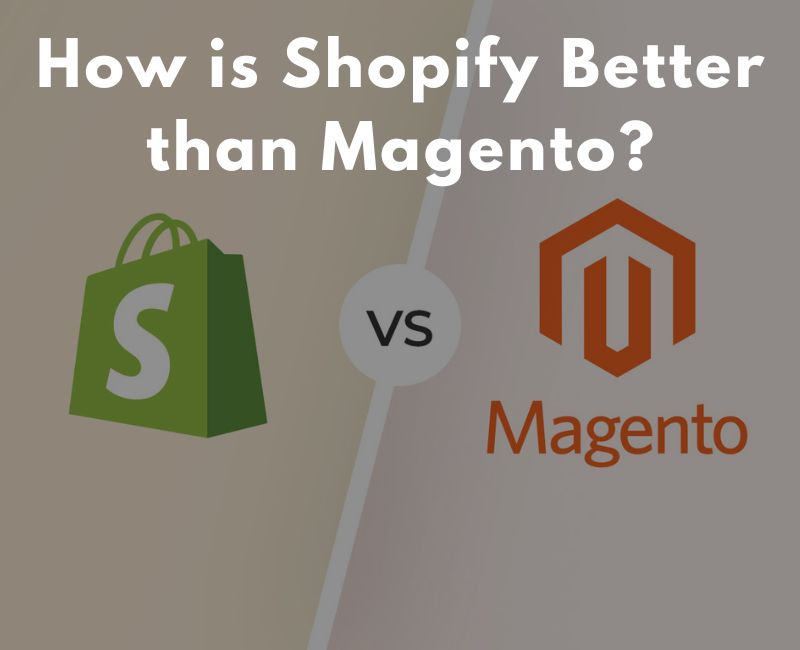
Overview: Magento vs Shopify
When two similar things strike together, it is a little confusing to choose which one is best, why it is best and its differentiation. Today we have a Comparison study in this blog post between two ecommerce platforms Magento Vs Shopify.
Unable to Choose between Shopify and Magento? It’s not just you. These two companies operate some of the most well-known e-commerce sites available currently in the market.
SHOPIFY: A simple solution for creating online storefronts is Shopify. It is capable of supporting both start-up and high-volume businesses. Only you need to do is what payment of a monthly price.
MAGENTO: Magento is an open-source platform like as that you can install on your computer for free. Although we’ll go into more depth about these expenses below, you will still have to pay for site hosting ($10 per month), security, and extensions (which are essentially apps).
Although it’s a sophisticated platform, without coding experience, it will be difficult to meet your ecommerce objectives. It works well for large companies with in-house development teams.
Magento Vs Shopify : 7 Key Differences
1. Pricing and Costs
Price is a crucial consideration when selecting a shopping cart. What proportion of your budget do you plan to spend on your store? Which one offers a better price for you, Magento or Shopify? We’ll discuss the differences between Magento and Shopify’s price-setting methods.
Magento pricing
In reality, Magento doesn’t need for a regular subscription. It costs nothing to download, install, and set up your store on this platform. To publish your website, you must, however, pay for a domain and a hosting company. As a result, the cost of Magento can vary depending on your choice.
Additionally, you might think about including a number of integrations on your website to expand the potential of your store. These applications can be purchased for up to $15,000 on the Magento App Market.
Shopify pricing
Shopify’s pricing is subscription-based, as opposed to Magento’s. You can choose from 5 price tiers, ranging from $9 to more than $2000 each month. Fortunately, this package covers the costs of both the domain and the hosting, so you need not to worry about purchasing the plans for extra.
2. Themes and Templates
For many of the companies, the thing which comes after the budget and ease of use is How their platform will look? Therefore, a customer’s first impression is a crucial one. Themes provide you the chance to showcase your gorgeous brand and unique personality.
Let’s compare the themes between Magento and Shopify.
Magento Themes
Costing upto $499, Magento provides 6 fully Mobile responsive themes. Magento also provides the feature to develop themes from scratch. (To develop a theme from scratch, you need to have high knowledge of coding or a Big budget to hire a developer)
Main Features:-
- It allows you resilient customization.
- It allows you to add animations to your store in order to make it more engaging.
- You can add on featured product slider to your homepage.
- The newsletter option can also be started in your Webpage Footer.
- You can add “Cross-selling block” on your product pages.
Shopify Themes
With 13 free and 73 paid themes, Shopify offers a large selection of themes for additional information. Even at the pricing range, items might be beyond reach for some clients because Shopify owners must spend between $150 and $350 on a theme for their attractive stores.
Highlight Features:-
- Your Shopify theme’s elements can be added, changed, removed, and resized using the drag-and-drop editing option.
- Every theme is optimised for mobile use.
- Simple page creation or addition.
- The colour scheme and the graphics can be changed to suit your business.
- You may quickly add social media feeds according to it.
3. Ease of Use
Most of the e-merchants who makes give their business, an online presence are neither Web designers nor developers. It is important for users to have a platform that is easy to set up and operate, even if they are familiar with basic principles.
Let’s know how Shopify and Magento are different from each other in terms of Usability.
Magento Ease of Use
Magento is not as user-friendly as Shopify. It is difficult for Non- tech user to operate Magento. It requires professional level knowledge to install and set up their online business. This provides user to Complete Control over their website.
Shopify Ease of Use
There are so many benefits which Shopify is clearly holding because Shopify itself has hosted platform. It is very easy to use. Moreover, Shopify is built while keeping this thought in mind that it can be operated by both Tech-savvy and People With non-technical background. As an output, users on Shopify need not to face much trouble as they can build their stores on their own.
4. Apps & Extension
Themes simply affect how your website looks and feels; if you want to add more functionality, you may do so by using extensions. App shops and extensions are offered by all systems. The majority of these programmes are accessible with only a click, enabling you to expand the functionality of your online store.
Magento extension
Currently, Magento provides about 3600 + Extensions from the Magento Marketplace. Moreover, no extra coding knowledge is required to install and use these extension.
Shopify Apps
More than 4200+ apps are available in the Shopify App Store, including free apps and paid ones for adding features, controlling your store, and boosting sales.
For more details, we give you access to various well-known Apps, such as Trust Hero by Booster Apps, which allows you to display trust icons to visitors and potential buyers to reduce cart abandonment.
Shopify additionally provides the benefit of integrating marketing email campaigns, such the MailChimp account, to get in touch with your target audience.
5. Payment Fee
Payment fees is the basic component in exchange for taking any kind of services. So, to compare the monthly payment fees in both the ecommerce platforms read the below given deep research.
Magento Payment
In actuality, Magento doesn’t support payments, so you must download the appropriate extension from the Magento marketplace and pay a transaction charge to use it. Magento currently offers store owners 339 options to choose from.
Shopify Payment
Shopify allows you to choose more than 100 payment gateways, but you need to pay some specific fees, which is Compulsory for all.
- Payment processing charge
- All transactions, including data transmission between buyers, sellers, issuing banks, and acquiring banks, will incur a cost from your payment provider. The Shopify Plan you select will determine how much you’ll be charged.
- Transaction Fees
Each transaction have different fees according to the plans purchased by you. The Following are the deduction amounts charged are:-
- Shopify Lite: 2.4 %
- Basic Shopify 2%
- Shopify 1%
- Advanced Shopify 0.5%
- Shopify plus 0.5 %
Shopify Payments is a user-friendly payment processor that is free for e-merchants to utilise, helping to reduce costs for them. However, clients can get a free transaction if they use Shop Pay!
6. Search Engine Optimization
Actually, SEO, which stands for search engine optimization, enables you to improve the SEO of your eCommerce website because it will influence how well your store ranks. Both shopping carts in the Magento vs. Shopify comparison offer choices in this area that are quite comparable.
Magento and Shopify SEO
You can quickly change the page title and description to control how your store appears in search results pages on Shopify and Magento SEO. You can also add alt text to photos to make them more understandable to search engines. To improve your online store’s Google ranking, for instance, have a look at our Magento SEO tutorial.
Additionally, the Shopify App Store and Magento’s Marketplace also sell other SEO applications. For instance, Shopify’s SEO Booster tool enables you to quickly identify issues with SEO and address them.
7. Help and Support
In every aspect of life, a person requires help and support. So, here both platforms have different policies to provide help and support.
Magento Support
Magento is a self-hosted platform, therefore unless you sign up for the Magento Commerce Cloud plan for B2B, it doesn’t provide live chat, phone, or email assistance along the way.
Instead, a fantastic user community is available to Magento users. You may currently get in-depth guidance from Magento specialists all over the world.
Besides this, there is an active help center that offers all-time support.
Shopify Support
Shopify outmatches competitors by providing pretty devoted help and support. A knowledgeable team is on call 24/7 by phone, email, and live chat to answer questions and provide quick solutions for clients’ issues. Additionally, Shopify users have access to the help center, API documentation, community forums, and a lot of video training.
To ensure optimum problem resolution and seamless business functioning, you may also use certified professional Shopify specialists.












